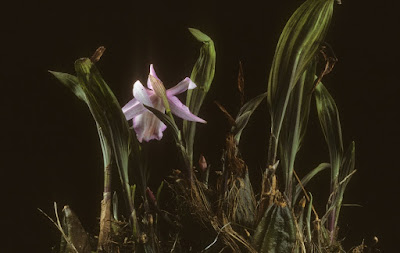Pleione coronaria is found in central Nepal. It grows on mossy branches in rhododendron woodlands at elevations of 2850 to 3500 meters above sea level.
Pleione coronaria also called as The Wreath-Shaped Pleione, is a species of the genus Pleione. This species was described by Phillip James Cribb & Chen Zhen Zi Tang in 1983.
IDENTIFY PLEIONE CORONARIA ORCHID PLANT
Pleione coronaria is found in central Nepal. It grows on mossy branches in rhododendron woodlands at elevations of 2850 to 3500 meters above sea level.
It is a small sized, cold growing terrestrial with clustered, often oblique, ovoid to ovoid conical pseudobulbs carrying a single, apical, spreading, lanceolate, acute leaf that gradually narrows to the crown like base especially visible after leaf fall.
The Wreath-Shaped Pleione blooms in the spring on an erect, 8 to 10 cm long, single flowered inflorescence with a cucullate, elliptic, rounded floral bract all arising on a newly arising pseudobulb through the new cupped leaf. The flowers are 7 cm in diameter.
PLEIONE CORONARIA ORCHID PLANT CARE AND CULTURE
Cultural information should only be used as a guide, and should be to be adapted to suit you. Your physical location; where you grow your plants, how much time you have to devote to their care, and many other factors, will need to be taken into account. Only then can you decide on the cultural methods that best suit you and your plants.
Light:
Pleione coronaria needs a light level of 18000-30000 lux. This species prefer about 50%-70% shade and should not be placed in full sun.
Temperature:
The recommended temperature is 25°C in summer and 1-5°C in winter. However they will tolerate higher summer temperatures of 35°C for short periods. They need cool to cold temperatures in winter of between 1 and 5°C.
Humidity:
The Wreath-Shaped Pleione need good air movement. Place them near the bottom of the shade house where it is coolest and humidity highest. Misting is beneficial in very hot weather.
Substrate, growing media and repotting:
Pleione coronaria grow best in squat pots. This plant require a free draining open potting mix. Small sized bark mixed with perlite in a 3:1 ratio is a suitable mix. Some growers use sphagnum moss instead of perlite but this can become soggy and perlite is considered a better option.
The plant should be repotted when they are dormant in winter. Their roots die at the end of the season. When repotting remove all the roots leaving about 3 cm of roots to anchor the pseudobulb in the compost.
Watering:
This orchid should be watered regularly through the warmer months but totally dry in winter. Water in the early morning and not during the heat of the day. Roots start to grow as the flowers die and only a little water should be given from this time on as they have yet to develop roots. Keeping them drier at the start of the growing season also encourages the roots to penetrate. Over watering during the early root growth stage is a major cause of plant loss. Once leaves are well developed they can be watered freely. Stop watering when the leaves go yellow and allow them to become completely dry.
Fertilizer:
You can use regular but weak liquid fertilizer during their growing period but not when they are dormant. Use a lower Nitrogen fertiliser at the end of summer to encourage flower bud development.
Rest period:
Pleione coronaria goes to sleep from November to February. This plant have a longer cold dormant period in winter than other Pleione species and can be kept in the fridge if necessary. Watering should be stopped when the leaves begin to fall. Fertilization should be stopped during this period. When new sprouts appears, the rest period end, the amount of water and fertilizer can be back to normal level.















COMMENTS